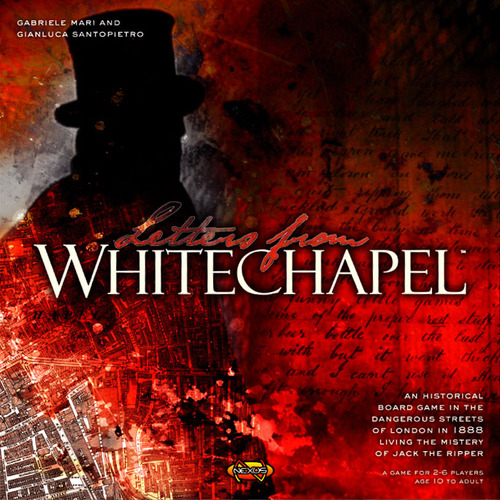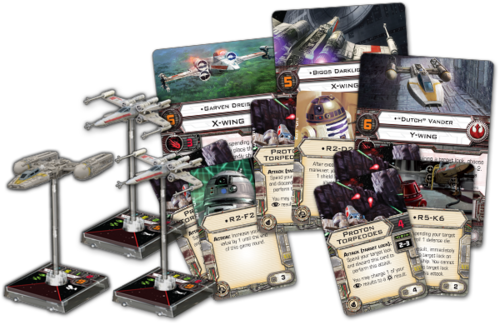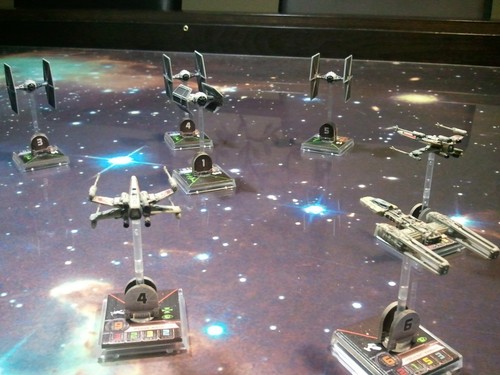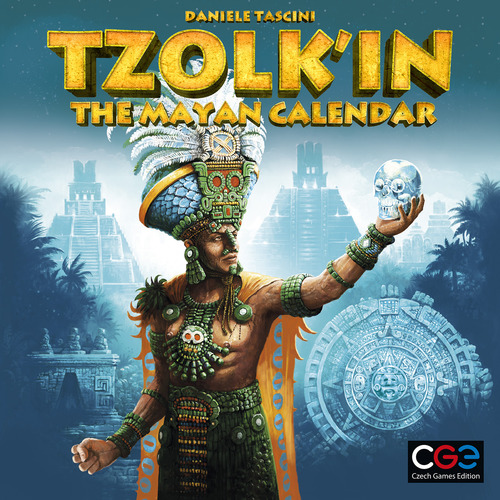 By Firestone
By Firestone
One of the most buzzed-about games of the last year was a little game called Tzolk'in. But it seemed like the interest might be simply because of the cool gears that cover most of the board. Well I've played it now, and I can assure you, there's a solid game to go with those cool gears.
The game is set in Central America during the time of the Mayans, and you're trying to earn the most VPs through careful placement of your workers. There's a large, ornate gear in the middle, and five smaller gears around that one. The large one acts as the game's "timer" It will turn once around, and then the game ends, while the smaller ones will turn many times over the course of that large gear's one turn. Science! There are also a few tracks—including a tech tree and three temple tracks. And there are spaces for buildings and monuments, which you'll buy with resources. The game crams a remarkable amount of information onto one board without becoming 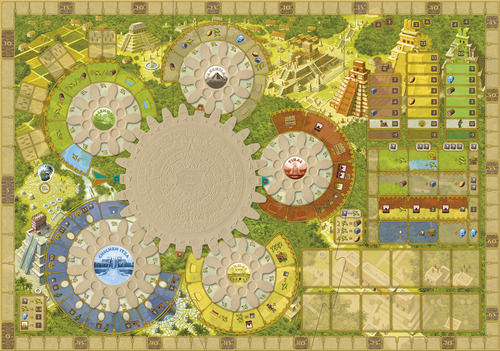 overwhelming.
overwhelming.
Turns are "simple": You will either place one or more workers onto the board, or you will take one or more workers off the board.
Each of the gears has spaces for the workers to sit on, and each gear has different actions around them. You have to place your worker on the lowest available space on each wheel, and possibly pay to do that. The spaces start at zero corn (the game's currency), and go up from there. So you have to pay corn to place your worker (unless it's on the lowest space, which is free), but you also have to pay for each worker you place beyond the first one each turn. And the prices ramp up for each worker, so you always have to carefully consider whether you can afford to place workers.
At the end of each turn, you turn the big gear, which turns the little gears, which move the workers on those gears. So each turn a worker will move ahead and be in front of a new action space. The spaces get better the further along the gear you go, but because you have to either place workers or take them off, it can be a tricky thing to get workers to ride that gear for a while.

When you decide to take a worker off a gear, he gets to do the action that's in front of him when you take him off. (If you decide you actually want to do an action further back on the gear—because something on the board changed, or you timed the taking off/putting on poorly, or whatever—you can, but you have to pay one corn for each space behind you that action happens to be.) One of the gears has actions that let you take corn or wood. One lets you get building resources, such as wood, gold, stone, or crystal skulls. The third gear has actions that let you advance the tech tree, build Buildings, and build Monuments. The fourth gear lets you do things such as pay corn to advance on the Temple track, get another worker to use in the game, and build a Building using corn rather than resources. The last couple of spaces on every gear allow you to take a earlier action on the gear, but without having to play the extra corn. The fifth gear is a little different, in that those spaces give you straight VPs and let you advance on the Temple track. The further on the wheel, the more VPs, but each space costs one crystal skull, so once someone has claimed a space with their skull, no one else can use that one.

As if all of that weren't enough, I still have way more stuff to explain!
There's a space where you can put a worker down to claim the first player marker. Each turn where no one does that, you put corn on the wheel. So as the corn adds up turn over turn, there's incentive for other people to grab that first player space.
So there are three Temple tracks. Since you're Mayans, and Mayans believed in many gods, you'll be trying to win the favor of the gods and advance on these tracks. It's not like there's a Sacrifice A Villager space—it's completely abstracted. You take an action on one of the wheels, and move your marker up the ziggurat. That gets you more VPs during scoring, and a couple of spaces give you resources, too. There is a mechanism in the game where you can beg for corn if you can't pay for something, but this "angers the gods"—which simply means you have to move down one of the tracks. It's not the focus of the game, and there's nothing that made me feel I was being asked to worship anything—it's just one of the game's mechanisms given a thematic coat of paint.
The tech trees let you do things such as gather extra corn when you take the Gather Corn action; get extra wood, stone, or gold when you gather that resource, or get resources when you build a Building—plus a few others. The tech trees are cool, but as with so many great games, you can't do everything, so you have to choose wisely, and hope your choices are better than your opponents' choices.

Finally, there are two tracks on the bottom of the board. One holds Buildings; at any time there will be six of them on the board. They let you do things, such as move up on a tech tree, or move up on Temple tracks, or spend less to feed your workers at the end of each turn. There are two batches of Buildings; you use the first ones in the first half, and switch to the second batch for the second half—and the second batch has better Buildings. Another reason to build Buildings is that some of the Monuments will give you VPs for having certain-colored Buildings.
The game comes with a number of Monuments, and each game you'll use exactly six of them. Those—unlike Buildings—won't be refilled. They give you bonuses and VPs at the end of the game, but you have to build them using resources, just like a Building.
The game is divided into four quarters, and at each quarter you'll have to feed your workers—two corn each unless you've built a farm Building. Unlike Stone Age, starving your people here is a BAD IDEA. Also depending on the quarter, you might score some of the Temples, or get some resources. After the last quarter, you count up VPs, add in bonuses from the board or from Monuments, do a couple of other fiddly things, and whoever has the most VPs, wins!
Whew! Well that's it. As you can see, there is a LOT going on. Your first game will probably take you a while, because even though you can only take off or put on workers, there is a lot to think about. This game is all about timing. You'll constantly be trying to figure out whether putting these guys down this turn will allow you to take that action later to get this resource to later turn into that Building provided your dude on that gear can ride far enough along to get to the Building action. This is NOT a light game...

One the great things about the game is that there are many things that change the experience from game to game. The Monuments are different each game, for one. Another thing is the starting resources. The game comes with tiles that have various bonuses on them, such as a free movement up one of the tech tracks, or another worker to start the game with, or a free skull, or moving up the Temple tracks. You get four tiles, and you choose two of them to start the game with. That will often determine what route you take (at least at the start). Your experience from game to game should be quite different. And because there are so many viable routes to victory, you'll feel complete freedom to explore a different strategy from game to game.
You'll need to determine if the Temple tracks are enough to keep you away from the game. Again, it's completely abstracted, but there is talk of "pleasing the gods" to move up, or "displeasing the gods" and having to move down. You're not sacrificing people to these gods, or worshiping them in any way. But we'd understand if that makes you uncomfortable.
This is one of the best games I've played in the past year. I can't wait to try out some new tactics and strategies—and I REALLY can't wait to get my grubby hands on a copy of the game, and paint those sweet gears. If you like deep games, and/or worker-placement games, check out Tzolk'in. It's way more that a gimmick.


